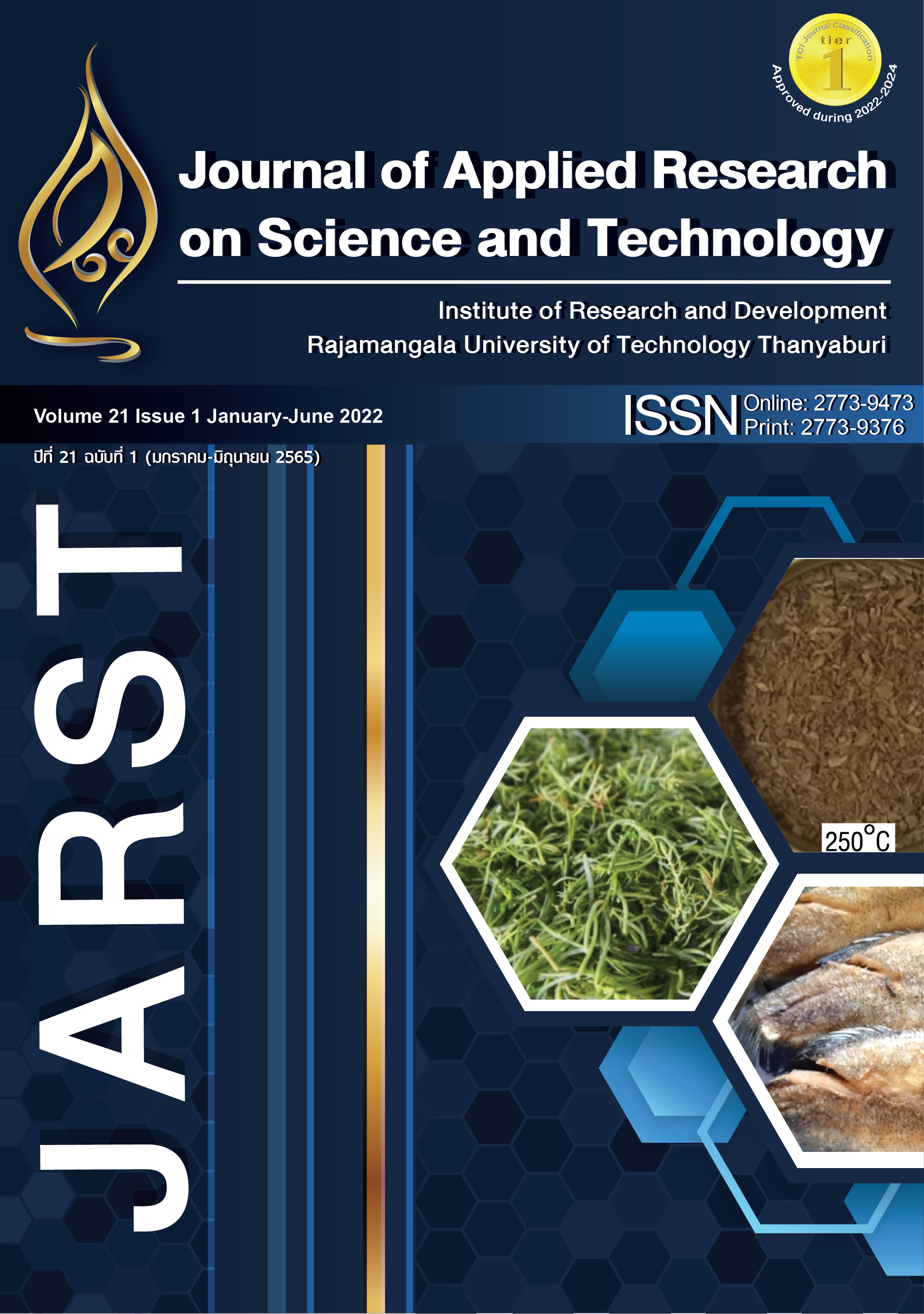Screening for Rice Blast Resistant Genes, Pi9, Pita, Pigm(t) and Pi54 in Landrace Rice Varieties of Northeastern Thailand
Main Article Content
Abstract
Rice blast disease, caused by Magnaporthe oryzae, is one of the most frequent and significant impediments to sustainable rice production and the largest impediment to sustainable rice production. Effective control of this disease largely depends on identifying the resistant genes. In our study, 37 Thai landrace rice varieties (18 white-grain rice varieties and 13 colored-grain rice varieties) along with 6 improved white-grain rice varieties were screened for four rice blast resistant genes, Pi9, Pita, Pigm(t) and Pi54 by PCR technique using the gene-specific makers. The results showed that 20 rice varieties (54.0%) contained the rice blast resistant gene Pi9, 11 rice varieties (29.7%) contained the rice blast resistant gene Pita, 22 rice varieties (59.4%) contained the rice blast resistant gene Pigm(t) and 23 rice varieties (62.1%) contained the rice blast resistant gene Pi54. All 31 Thai landrace rice varieties carried at least one rice blast resistant gene(s). Four white-grain landrace rice varieties, four colored-grain landrace rice varieties and five improved rice carried the highest number of rice blast resistant genes at three genes, which can be used as the resistant donor in the rice breeding program. Two white-grain landrace rice varieties; Jao Dæng 2 and Mak Yom, contained one examined rice blast resistant genes. Two colored-grain landrace rice varieties; Nieow Dam (skn 3) and Kee Nok, contained all examined rice blast resistant genes. Five improved rice varieties contained three rice blast resistant genes. The information generated from this study is useful for parental selection in developing the new resistant rice varieties and breeding.
Article Details

This work is licensed under a Creative Commons Attribution-NonCommercial-NoDerivatives 4.0 International License.
References
Ahn SN, Kim YK, Hong HC, Han SS, Kwon SJ, Choi HC, et al. Molecular mapping of a new gene for resistance to rice blast. Euphytica. 2000;116:17–22.
Dean RA, Talbot NJ, Ebbole DJ, Farman ML, Mitchell TK, Orbach MJ, et al. The genome sequence of the rice blast fungus Magnaporthe grisea. Nature. 2005;434:980–6.
Sharma TR, Rai AK, Gupta SK, Vijayan J, Devanna BN, Ray S. Rice blast management through host-plant resistance: Retrospect and prospects. Agr Res. 2011;1(1):37–52.
Qu S, Liu G, Zhou B, Bellizzi M, Zeng L, Dai L, et al. The broad spectrum blast resistance gene Pi9 encodes a nucleotide-binding site leucine-rich repeat protein and is a member of a multigene family in rice. Genetics. 2006;172:1901–14.
Bryan GT, Wu KS, Farrall L, Jia YL, Hershey HP, McAdams SA, et al. Single amino acid difference distinguishes resistant and susceptible alleles of the rice blast resistance gene Pi-ta. Plant Cell. 2000;12:2033–46.
Deng Y, Zhu X, Shen Y, He Z. Genetic characterization and fine mapping of the blast resistance locus Pigm(t) tightly linked to Pi2 and Pi9 in a broad spectrum resistant Chinese variety. Theor Appl Genet. 2006;113:705–13.
Doyle JJ, Doyle JL. A rapid DNA isolation procedure for small quantities of fresh leaf tissue. Phytochemical Bulletin. 1987;19:11–5.
Imam J, Alam S, Mandal NP, Variar M, Shukla P. Molecular screening for identification of blast resistance genes in north east and eastern Indian rice germplasm (Oryza sativa L.) with PCR based markers. Euphytica. 2014;196(2):199–211.
Jia Y, Wang Z, Singh P. Development of dominant rice blast Pi-ta resistance gene markers. Crop Science. 2002;42:2145–9.
Deng Y, Zhu X, Xu J, Chen H, He Z. Map-based cloning and breeding application of a broad-spectrum resistance gene Pigm to rice blast. In: Wang, GL and Valent, B (eds). Advances in Genetics, Genomics and Control of Rice Blast Disease. Dordrecht: Springer. 2009;161–71.
Villa TCC, Maxted N, Scholten M, Ford-Lloyd B. Defining and identifying crop landraces. Plant Genetic Resources. 2006;3:373–84.
Yadav MK, Aravindan S, Ngangkham U, Raghu S, Prabhukarthikeyan SR. Correction: Blast resistance in Indian rice landraces: Genetic dissection by gene specific markers. Plos One. 2019;14(3):e0213566.
Koide Y, Kobayashi N, Xu D, Fukuta Y. Resistance genes and selection DNA markers for blast disease in rice (Oryza sativa L.). The Japan Agricultural Research Quarterly. 2009;43(4):255–80.
Kobayashi A, Ebana K, Fukuoka S, Nagamine T. Microsatellite markers revealed the genetic diversity of an Old Japanese Rice Landrace ‘Echizen’. Genet Resour Crop Ev. 2006;53(3):499–506.
Chaipanya C, Telebanco-Yanoria MJ, Quime B, Longya A, Korinsak S, Korinsak S, et al. Dissection of broad-spectrum resistance of the Thai rice variety Jao Hom Nin conferred by two resistance genes against rice blast. Rice. 2017;10–8.
Wattanaporn T, Ing-on S, Kritkittisak P, Sureeporn K-N, Chatchawan J. Gene specific marker screening and disease reaction validation of blast resistant genes, Pid3, Pigm and Pi54 in Thai landrace rice germplasm and recommended rice varieties. Plant Genetic Resources. 2019;17(5):421–6.
Agrawal GK, Pandey RN, Agrawal VP. Isolation of DNA from Choerospondias asillaris leaves. Biotechnology and Biodiversity Letters. 1999;2:19–24.
Liu G, Lu G, Zeng L, Wang GL. Two broad-spectrum blast resistance genes, Pi9(t) and Pi2(t), are physically linked on rice chromosome 6. Mol Genet Genomics. 2014;267:472–80.
Liang ZJ, Wang L, Pan QH. A new recessive gene conferring resistance against rice blast. Rice. 2016;9:47–52.


